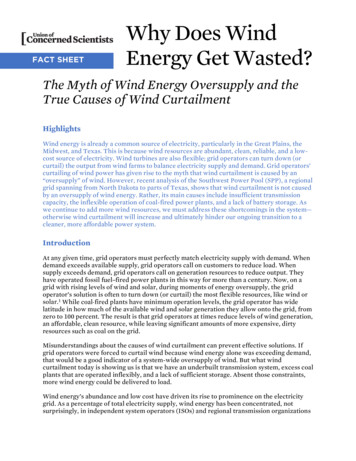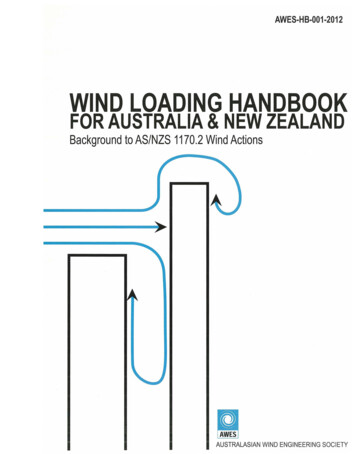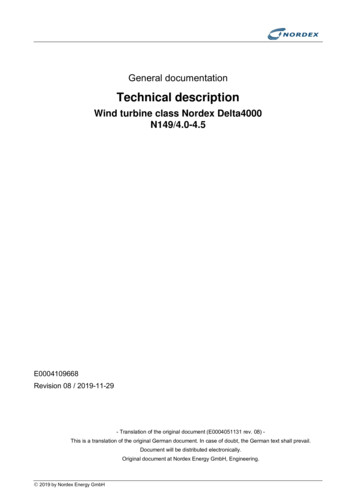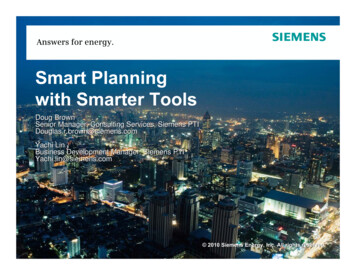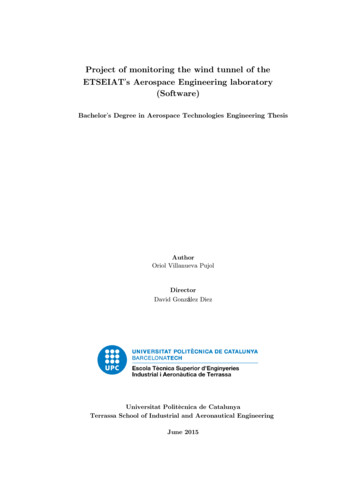
Transcription
Project of monitoring the wind tunnel of theETSEIAT’s Aerospace Engineering laboratory(Software)Bachelor’s Degree in Aerospace Technologies Engineering ThesisAuthorOriol Villanueva PujolDirectorDavid González DiezUniversitat Politècnica de CatalunyaTerrassa School of Industrial and Aeronautical EngineeringJune 2015
AcknowledgmentsI would really thank to everybody who has contributed to make this projectbecome true.First of all my colleague and fellow sufferer Joan Pallejà who has always helpedwith any issues related to my part of the project, just as I have tried to helphim, in order to achieve the common goal.The director of the project, Mr. David González, has also been a cornerstone ofthe troubleshooting process implied in the theses. Thanks to his experience inelectronics he has backed us up during the whole project while workingtogether to figure out the best solution possible, as well as revising the writtendocuments.It would be really unfair if no gratitude is shown to Mr. Josep Farré Lladós towhom we are in debt. He opened to us the aerospace engineering laboratory’sdoors and has always been there helping us with everything we needed like theformal written style, supply of materials and technical aspects.Another important person for the steady development of the project has beenMr. Enrique Ortega. Not only has he helped us to understand the physicalprinciples that rule the tunnel’s behaviour but also with the thoroughcalibration process. It was during this calibration process where we alsoreceived the invaluable help of Professor Josep Maria Gibert, who registersmeteorological values at the university since 1977, and without whom theatmospheric pressure calibration would not have been possible.Finally I would like to thank Jeff Parker who has taken care of correcting someEnglish written aspects.After giving my most sincere thanks to these people, I cannot finish withoutrecognizing the support of family and friends. They are always there ineveryday life doing the impossible to support and help me. I can be pretty surethat without them neither this thesis nor the degree would have concluded insuch a successful way.Oriol Villanueva PujolI
AbstractThe ETSEIAT’s aerospace engineering laboratory’s wind tunnel used to varyits airflow speed thanks to a potentiometer and the air properties weremanually measured. Hence, monitoring the tunnel’s behaviour was the goal.This aim was to be achieved by making use of an Arduino, the proper sensorsand genuine software in order to have better control of the velocity and togather data automatically.Taking this into consideration, a Matlab code which interacts with Arduinowas created. It collects the temperature, the atmospheric pressure and thedifferential pressure at the nozzle, and saves and plots in real time all the data.Moreover, it calculates and stores the air speed as well as comparing it to thedesired velocity so as to obtain the error, which is aimed to be minimized, andis later on processed by a PID controller.After mounting the whole system with the appropriate hardware, the sensorswere tested and some of them re-calibrated to reduce, as much as possible, allthe uncertainties and get a simultaneously efficient, accurate and robustsystem.Once all the difficulties have been solved it is possible to say that the projecthas finally been carried out with a greatly satisfactory result and it will be auseful tool for the university.Oriol Villanueva PujolII
Bachelor’s thesisContentsAcknowledgments . 1Abstract . 1Aim of the project . 1Scope of the project . 3Basic requirements of the project . 5Justification . 7Background and State of the art . 9Arduino Board . 136.1Arduino board choosing process . 156.1.16.2Key aspects at the time of choosing . 15Arduino programming software . 16Physical understanding of the wind tunnel . 17Arduino connection with computer . 27Control of Altivar31 VSD, connection and data exchange with Arduino 299.1Altivar 31 VSD . 299.2Arduino Board . 319.3Software . 329.4Difficulties . 35Pressure transducer integration in the system . 4110.1Pressure transducer . 4110.2Arduino Board . 4210.3Software . 43Pressure sensor integration in the system . 4711.1Pressure sensor . 4711.2Arduino Board . 4811.3Software . 48Temperature NTC sensor integration in the system . 5112.1Temperature sensor. 5112.2Arduino Board . 5312.3Software . 53Oriol Villanueva PujolIII
Project of monitoring the wind tunnel of the ETSEIAT’s Aerospace Engineering laboratoryCalibration process . 57Arduino board software programming . 6514.1PID. 65Real time data logging of the testing zone’s balance. 7515.1Testing zone’s balance. 7515.2Real time data logging . 78Final result and analysis . 81Economy, environment and safety . 87Planning. 8918.1Initial planning. 8918.2Tasks done . 9118.3Future planing . 93Conclusions and recommendations . 95Bibliography . 97Oriol Villanueva PujolIV
Bachelor’s thesisList of .7.2.7.3.7.4.7.5.Potentiometer control method. 7Open wind tunnel schematic section [1] . 9Laboratory's Wind tunnel . 10A-Manometer B-Former thermometer and Barometer . 11Initial wiring diagram [5] . 11Arduino IDE . 16Closed return tunnel [8] . 17Open return wind tunnel [4] . 18Wind tunnel's air properties . 21Pitots tube mounting. 22qc f(ΔPsT) . 23Figure 7.6. Patm-PsC f(ΔPsT) . 23Figure 9.1. Altivar 31 VSD . 29Figure 9.2. Wiring diagram, velocity control [20] . 29Figure 9.3. Wind tunnel's fan . 30Figure 9.4. Altivar 31 and Mode selection box . 31Figure 9.5.Arduino-Altivar31 conditioning circuit [5]. 32Figure 9.6. Board testing circuit [5] . 35Figure 9.7. Induced tension on Altivar input . 37Figure 9.8. Real wire's behaviour at high frequency . 37Figure 9.9. Representation of parasitic capacitors between wires and ground 38Figure 9.10. Square wave and its derivative [25] . 38Figure 9.11. Diode and transistor bridge in Altivar . 39Figure 9.12. Normal wire substitution for shielded one . 39Figure 10.1. Holes for measuring differential pressure . 41Figure 10.2. Pressure transducer installed . 42Figure 10.3. Pressure-Arduino conditioning circuit [5] . 42Figure 11.1. Ambient pressure sensor installed . 47Figure 12.1. NTC sensor position . 51Figure 12.2. NTC sensor . 52Figure 12.3. NTC conditionning circuit [5] . 52Figure 13.1 Atmospheric pressure calibration correlation . 59Figure 13.2. Velocities sweep for calibration . 60Figure 13.3. Alcohol manometer . 61Figure 13.4. Schematics of the verification mounting for differential pressure . 62Figure 13.5. Calibration line for differential pressure . 63Figure 14.1. Open and feedback loop systems [37] . 65Oriol Villanueva PujolV
Project of monitoring the wind tunnel of the ETSEIAT’s Aerospace Engineering .2. PID system schematics [34] . 6614.3. Proportional effect on error [38] . 6714.4. Integral action to reduce e(t) [45] . 6814.5. Derivative action versus the error [44] . 6814.6 PID step response [39] . 7014.7. Kp variations with Ki, Kd constant [34] . 7114.8. Ki variations with Kp, Kd constant [34] . 7114.9. Kd variations with Kp, Ki constant [34] . 7214.10 Step response of the system . 7315.1. Sting balance provided by Aerolab [44] . 7515.2. Pin's configuration [44] . 7615.3. Yawing moment graph [44]. 7615.4 D-SUB 15 Balance connector [44] . 7816.1. Final component's installation . 8116.2 Final layout electric schematics . 8216.3 GUI: Mode Selection Window . 8216.4. GUI: Manual mode window . 8316.5. GUI: Ramp Mode window . 8316.6. GUI: Step Mode window . 8417.1. Emergency . 8717.2. Polyester box [45] . 8818.1 Task identification . 8918.2. Gantt chart . 90Oriol Villanueva PujolVI
Bachelor’s thesisList of tablesTableTableTableTableTableTableTableTable7.1. Uncertainties values examples . 267.2. Maximum uncertainty . 2613.1. Voltage read vs Atmospheric pressure . 5813.2. Comparison between readings . 6013.3. Manometer vs sensor readings and error . 6214.1. Ziegler-Nichols method [43] . 7214.2. Effects of increasing a parameter independently [43] . 7314.3. Constant values for the PID . 73Table 18.1. Hour estimation for tasks. 91Table 18.2. Tasks done . 92Table 18.3. Future planing . 93Oriol Villanueva PujolVI
Aim of the projectThe main goal of this final degree project is to monitor and automate the windtunnel of the ETSEIAT’s aerospace engineering laboratory by replacing theactual manual-working potentiometer with an automatic microcontroller, whichwill be an Arduino that is an open-source computer hardware and softwareplatform which is based on a family of microcontroller boards.In order to be able to accomplish the aim of the project the controller’ssoftware should be carefully programmed. Moreover, transmission andcommunication for both controlling and acquiring data has to be studied so asto give the system capability to perform preprogramed tests as well as gatherautomatically all the required information resulting from the airflow around thesample in the wind tunnel.It must also be taken into consideration the fact that the final target is toprovide the university with a properly working and useful system for thefuture, no matter what difficulties have to be overcome.In the end, always under laboratory’s technician supervision, the system mustbe calibrated and veryfied by doing some experimental tests.Oriol Villanueva Pujol1
Project of monitoring the wind tunnel of the ETSEIAT’s Aerospace Engineering laboratoryScope of the project Familiarize with ETSEIAT’s aerospace engineering laboratory’s windtunnel and its actual working method. Create a connection interface between Arduino board and anycomputer for data sending and acquisition. Control of the Altivar 31 variable speed drive. Integrate the NTC temperature sensor and the pressure sensor to thegeneral system to modify air velocity from acquired data. Properly program the Arduino microcontroller board. Automatically measure and process all data from testing. Test the whole system by doing experimental tests.Oriol Villanueva Pujol3
Project of monitoring the wind tunnel of the ETSEIAT’s Aerospace Engineering laboratoryBasic requirements of the projectThe designed system for monitoring the wind tunnel shall fulfil what is statedbelow: Allow students and laboratory technicians to pre-program wind tunneltests with different velocity ranges. The total budget of the system must be affordable for ETSEIAT, whichis a public university. As much as it is possible the already existing hardware in the aerospaceengineering laboratory has to be used. All results from sample’s testing must be trustworthy and accurate. The system must be robust and shouldn’t induce any error duringexperimental tests. The Arduino Board and its additional hardware must be a suitablesubstitute for the actual potentiometer, allowing total control in aneasier and more defined way.Oriol Villanueva Pujol5
Project of monitoring the wind tunnel of the ETSEIAT’s Aerospace Engineering laboratoryJustificationAt the beginning of the project the laboratory’s wind tunnel was controlled bya potentiometer. Inside the red square on Figure 4.1 it can be appreciated theformer assembly. The “control box” had a selector to turn the tunnel on or stopit, as well as a potentiometer. Once the selector was in the ON position, thepotentiometer started its function allowing the tunnel to go from the 0% of itsvelocity, still air, when in the 0 position; and to its maximum velocity (100%)when the potentiometer was turned until 10.Figure 4.1. Potentiometer control methodThis control method didn’t allow the user to really know the real speed thatthere was on the testing zone since the differential pressure, ambient pressureand temperature were noted down manually and then some calculus were stillhave to be made, as it will be explained in section 7. That’s why the universitysuggested to do this project, they wanted an automatic system able to controlthe tunnel’s speed in order to perform more accurate tests.Besides this, the project is very interdisciplinary because it implies thecombination and development of acquired skills in subjects such as Informatics,Electronic circuits, Aerodynamics, Automatic Control, etc. which made it verysuitable as a final thesis of a Bachelor’s degree in aerospace engineering.Oriol Villanueva Pujol7
Bachelor’s thesisMoreover it has also facilitated the continued development some skills alsoacquired during the degree like reliable use of information resources, selflearning, summary and analysis capability, effective oral and writtencommunication, etc.Oriol Villanueva Pujol8
Project of monitoring the wind tunnel of the ETSEIAT’s Aerospace Engineering laboratoryBackground and State of the artA wind tunnel is a very common tool used to study the aerodynamic effects ofair moving around a solid sample. It is the next step to computational fluiddynamics tools, when a model gives well results numerically then it can be builtand tested in a tunnel. A wind tunnel consists of a duct passage, usually squareor circle shaped, which has the solid object in its middle that has to be tested.Air is blown or sucked through the tunnel, usually by means of a fan system,which also tries to eliminate turbulence, thanks to so called turbulence screens.The wind tunnel model is equipped with suitable instrumentation to measureaerodynamic forces, pressure distribution or other aerodynamic-relatedcharacteristics. Usually, some environmental properties are also measured. Thetraditional schematic section of a wind tunnel can be seen in Figure 5.1Figure 5.1. Open wind tunnel schematic section [1]The earliest wind tunnels were invented towards the end of the 19th century,in the early days of aeronautic research, when many attempted to developsuccessful flying machines. Nonetheless its development may be owed to anEnglish military engineer and mathematician Benjamin Robins who invented awhirling arm to determine drag and did some of the first experiments inaviation theory. Afterwards, after realising that the system had to be improvedin order to get a reliable airflow around the testing shape, Francis HerbertWenham a Council Member of the Aeronautical Society of Great Britain,addressed these issues by inventing, designing and operating the first enclosedwind tunnel in 1871.On the first years of aviation, specially empowered by wartime, aerodynamictesting, and with so wind tunnels, had a rapid development.Nowadays, in the 21st century, the vast majority of companies which workwith aerodynamic-related industries like the automotive sector, airplanedesigners, windmills, motorsports(F1) etc. own or use a wind tunnel to testtheir latest developments before launching new products. Not only are thebusinesses which use wind tunnels but also scientific research centres anduniversities. [1] [2] [3] [4]Oriol Villanueva Pujol9
Bachelor’s thesisThe aerospace engineering laboratory of ETSEIAT, in its effort to be at the topof world aeronautics universities, is working to improve the wind tunnel’sinstrumentation. On this basis, the current manually controlled system will bereplaced by an automatic one, allowing preprogramed tests, and real-time datalogging, with all the advantages that this implies.The approach of this project is to substitute the variable resistor by anArduino board which will have the static pressure variation in the nozzle, theatmospheric pressure, fluid’s temperature in the nozzle and the desired velocityof testing chamber as inputs. With all this information Arduino will send a setvalue to the Altivar31 variable speed drive. Moreover, Arduino will also haveas outputs, stored in the computer, the physical air variables that will bemeasured in the tunnel and the results of the testing zone balance.The ETSEIAT’s wind tunnel is a small open-circuit wind tunnel that isdesigned for lowspeed, subsonic testing. Hence, the equations that govern theair flow through the duct(conservation of mass, momentum and energy), can besimplified under isentropic and irrotational assumptions, and Bernoulli’sequation can be used everywhere in the fluid field.The aerospace engineering laboratory’s wind tunnel can be seen in Figure 5.2.Figure 5.2. Laboratory's Wind tunnelThe air properties required for processing test results have been measuredmanually until now. These quantities typically are:The air temperature which consisted of a single measurement in the existingthermometer with 0.1ºC resolution.The atmospheric pressure was also quantified with only one read value with thehelp of the mercury barometer in Figure 5.3-B.Oriol Villanueva Pujol10
Project of monitoring the wind tunnel of the ETSEIAT’s Aerospace Engineering laboratoryThe differential pressure across the nozzle is typically evaluated by using awater differential manometer like that in Figure 5.3-A. The two pipes in thenozzle conduct the air to the U-tube and the differential pressure can beobtained by the difference of the columns water levels, then the measure isconverted from millimetres of water column to Pa. Measurements withelectronic transducer are only used for selected tests.Figure 5.3. A-Manometer B-Former thermometer and BarometerTo conclude this part, it is important to note that the tunnel speed iscontrolled and powered on with the selector in Figure 4.1, which corresponds tothe electric schematics in Figure 5.4.Figure 5.4. Initial wiring diagram [5]Oriol Villanueva Pujol11
Project of monitoring the wind tunnel of the ETSEIAT’s Aerospace Engineering laboratoryArduino BoardFrom the official Arduino website [6] one can extract the following definition:“Arduino is a tool for making computers that can sense and control more of thephysical world than your desktop computer. It's an open-source physicalcomputing platform based on a simple microcontroller board, and adevelopment environment for writing software for the board.”So, what it can be said about Arduino is that they are an open-sourcecomputer hardware and software company, project and user community thatdesigns and manufactures kits for building digital devices and interactiveobjects that can sense and control the physical world surrounding it, which inthis paper will be the ETSEIAT’s aerospace engineering wind tunnel. Arduinoboards may be purchased preassembled, or assembled from scratch. As theproject was not thought to learn neither PCB design nor electronic componentsassembly, a preassembled board is chosen.The Arduino project is based on a family of microcontroller board designsmanufactured primarily by SmartProjects in Italy, and also by several othervendors, using various 8-bit Atmel AVR microcontrollers or 32-bit Atmel ARMprocessors. These systems provide sets of digital and analog I/O pins that canbe interfaced to various extension boards and other circuits. The boards featureserial communications interfaces, including USB on some models, for loadingprograms from personal computers. For programming the microcontrollers, theArduino platform provides an integrated development environment (IDE)based on the processing project, which can be freely downloaded from thecompany website, and includes support for C and C programminglanguages.The first Arduino was introduced in 2005 as a project for students at theInteraction Design Institute Ivrea in Ivrea, Italy. The project leaders sought toprovide an inexpensive and easy way for hobbyists, students, and professionalsto create devices that interact with their environment using sensors andactuators since at the time being they were using a “BASIC stamp” which cost 100. A hardware thesis contributed for a wiring design by Colombian studentHernando Barragan. After the wiring platform was complete, researchersworked to make it lighter, less expensive, and available to the open sourcecommunity.Common examples for beginner hobbyists include simple robots, thermostatsand motion detectors. Adafruit Industries estimated in mid-2011 that over300,000 official Arduinos had been commercially produced, and in 2013 that700,000 official boards were in users' hands. The use of the board and softwarethat is being described in this paper is merely for learning purposes, since bothOriol Villanueva Pujol13
Bachelor’s thesisin the designing phase and in its lifespan it is going to help other students fromETSEIAT to perform aerodynamic tests.This kind of boards can be used to develop interactive objects, taking inputsfrom a variety of switches and sensors, besides controlling a variety of lights,motors, and other physical outputs according to the user’s needs. Arduinoprojects can be stand-alone, or they can communicate with software running onthe computer (e.g. Flash, Matlab, and MaxMSP). One of the most importantaspects of the Arduino, which is the one that makes it so suitable for any kindof purposes, is its standard connectors, which lets users connect the CPU boardto a variety of interchangeable add-on modules known as shields. Some shieldscommunicate with the Arduino board directly over various pins, but manyshields are individually addressable via an I2C serial bus.The reader may wonder why Arduino was chosen instead of some othermicrocontroller based boards available, for physical computing, which offersimilar functionality. All of these tools take the messy details of microcontrollerprogramming and wrap it up in an easy-to-use package. Arduino also simplifiesthe process of working with microcontrollers, but it offers some advantage forteachers, students, and interested amateurs over other systems:Cost reason: Arduino boards are relatively inexpensive compared to othermicrocontroller platforms. The least expensive version of the Arduino modulecan be assembled by hand, and even most of the pre-assembled Arduinomodules cost less than 50. Apart from that, the college already had someboards by the time the system was chosen.Cross-platform: The Arduino software runs on Windows, Macintosh OSX, andLinux operating systems. Most microcontroller systems are limited to Windows,even if that was not really an issue as Windows is being used, anotheradvantage was the free IDE software that the company provides to usersbesides the great deal of examples it provides for beginners to start.Simple, clear programming environment: The Arduino programmingenvironment is easy-to-use for beginners, yet flexible enough for advanced usersto take advantage of as well. As a student of engineering one may have learnedto program languages such as C or C , programming in that environmentwill be familiar with the look and feeling of Arduino.Open source and extensible software: The Arduino software is published asopen source tools, available for extension by experienced programmers. Thelanguage can be expanded through C libraries. Similarly, people can addAVR-C code directly into their Arduino programs if they want to.Open source and extensible hardware: The Arduino is based on Atmel'sATMEGA8 and ATMEGA168 microcontrollers. The plans for the modules arepublished under a Creative Commons license. Although it is not the casetreated in this project, relatively inexperienced users can build the breadboardversion of the module in order to understand how it works and save money.Nonetheless it can interact with so many shields that it is difficult not to findthe one that sui
Project of monitoring the wind tunnel of the ETSEIAT's Aerospace Engineering laboratory (Software) Bachelor's Degree in Aerospace Technologies Engineering Thesis Author Oriol Villanueva Pujol Director David González Diez Universitat Politècnica de Catalunya Terrassa School of Industrial and Aeronautical Engineering June 2015 . Acknowledgments I would really thank to everybody who has .




